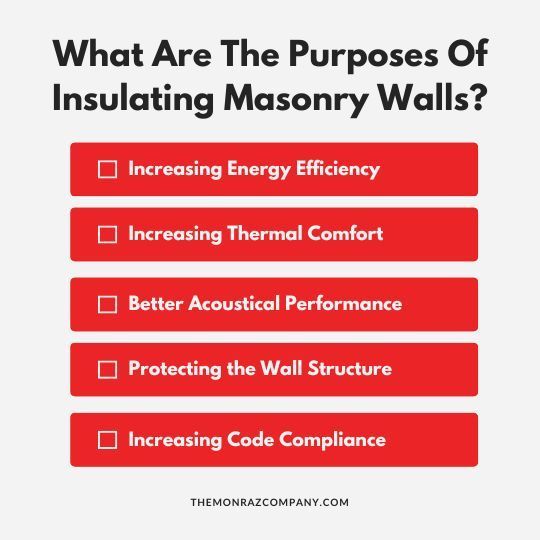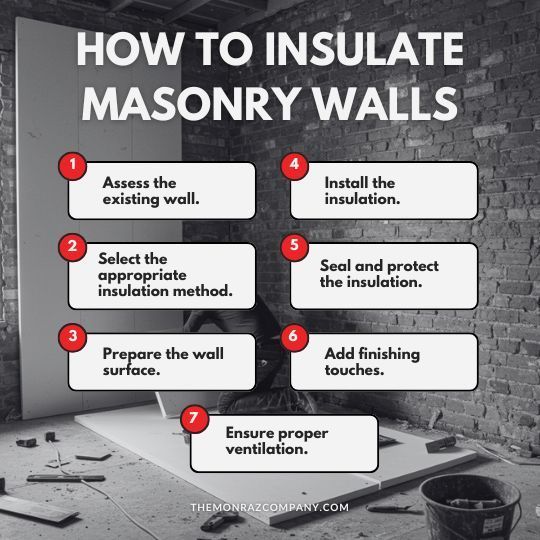Masonry Wall Insulation: Everything You Need to Know
It's no longer news that masonry walls are a popular choice for most commercial construction. This is due to its thermal mass, durability, and strength. This makes such properties rigid and strong against elements, making masonry walls a smart choice either for new buildings or renovation of existing ones.
One major hiccup that comes with masonry buildings is that to truly optimize its performance for the comfort you desire, it must be insulated. But not to worry today we will address everything there is to know about masonry wall insulation. We will look into what it is, explain why it’s done, demonstrate the methods of insulation, and provide a step-by-step guide on how to insulate your masonry and walls properly.
But before we dive in, If you have repair and construction questions needing expert answers, call the experts at TMC Engineering! If you're in Southern California, we can instruct you on your problem and perform whatever repair is necessary. We've got an expert solution for all your asphalt or concrete needs!

What Is Masonry Wall Insulation?
Masonry wall insulation is generally the process of placing thermal barriers in masonry walls made from brick, concrete, or stone to reduce heat transfer. The process changes the wall system to trap air, reflect radiant heat, or prevent conductive energy loss.
Masonry walls come with inherent thermal mass which is more of a double-edged sword. They can be useful in retaining heat yet also allow for significant heat loss depending on the method of construction and the climate of the area. Mitigating these issues will require insulation of these walls to make the building comfortable and reduce energy costs.
Different Methods of Masonry Wall Insulation
1.
Rigid foam insulation: Boards or panels made from materials like
expanded
polystyrene(EPS),
extruded polystyrene (XPS), or
polyisocyanurate(Polyiso) that are installed between the wall and an outer layer, such as brick or stucco
2. Loose-fill insulation: Blown-in or poured insulation materials, like cellulose or fiberglass, that fill the cavities within the masonry wall
3.
Reflective insulation: Aluminium foil-faced insulation panels or rolls that reflect radiant heat, creating a reflective air space between the insulation and the masonry wall
4. Insulated concrete forms (ICFs): Hollow foam blocks or panels that are filled with concrete, providing both structural and insulating properties
Factors like the existing wall construction, the desired level of thermal and acoustic performance, code compliance, and the overall budget for the project determine the choice of insulation method to adopt among these options. There are also hybrid systems that combine natural kraft paper with vapor barriers.
What Are The Purposes Of Insulating Masonry Walls?
In a bid to ensure overall energy efficiency, comfort, and longevity, insulating masonry walls services some very specific purposes.
Increasing Energy Efficiency
Masonry wall insulation minimizes heat transfer by regulating the temperature within the building. This conserves energy used for heating and cooling the building so you have reduced utility bills to contend with. Overall, you have a stable, comfortable indoor climate.
Increasing Thermal Comfort
Indoor temperature changes lead to cold and hot spots all over the building. This is uncomfortable for the occupants and reduces their general well-being. Insulated masonry walls help keep the indoor temperature more stable and constant by reducing such changes.
Better Acoustical Performance
Masonry wall insulation is not limited to thermal benefits only. It is also necessary for improving the acoustic properties of the building. Insulating masonry walls reduces the transfer of sound from one room to another and from the exterior. This can be a great benefit to have in commercial buildings that have multi-units carrying out various types of activities.
Protecting the Wall Structure
Insulating your masonry walls prevents moisture from forming on the walls itself. Wall moisture buildup allows mold and mildew to grow and, with time, can lead to structural weakening. This usually affects the life of the wall system and the building as a whole. Closed-cell spray foam prevents 99% of water vapor penetration. You also get to avoid spalling (surface flaking) in freeze-thaw conditions.
Increasing Code Compliance
Given these benefits, most energy efficiency codes and building regulations have made it compulsory to have a degree of insulation in masonry walls. Depending on the category of building and natural climate in the area, the amount needed will vary. Insulating your masonry walls will make sure that your building project meets the requirements.
By fulfilling these initial purposes, masonry wall insulation is a sound choice to improve the overall function and comfort of your building and its long-term value and longevity.

What Are Some Ways Of Insulating Masonry Walls?
There are a couple of effective ways of insulating masonry walls, each with its unique advantages and considerations. Here's a closer look at the most common approaches:
Exterior Insulation Finishing System (EIFS)
EIFS involves applying a layer of rigid foam insulation to the exterior of the masonry wall, followed by a weather-resistant coating or finish. This approach helps maintain the thermal mass of the masonry while adding an insulating layer on the outside. It also shields the masonry from the damaging effects of rain and weathering.
Cavity Wall Insulation
This method involves filling the hollow space or "cavity" between the outer masonry wall and an inner wythe (layer) of masonry or framing. Loose-fill or spray-in insulation materials are commonly used for this purpose.
Insulated Concrete Forms (ICFs)
ICFs are hollow foam blocks or panels that are filled with concrete, to create a self-insulating wall system. The foam provides both structural integrity and insulation, making it a convenient choice for new masonry construction.
Rigid Foam Insulation
Rigid foam boards or panels, such as EPS, XPS, or Polyiso, can be installed on the exterior or interior of a masonry wall, providing a continuous insulating layer. It is usually adhered directly to the masonry with construction adhesives. This approach helps minimize thermal bridging and can be combined with other finishing materials.
Reflective Insulation
Foil-faced insulation products, like radiant barriers or reflective air spaces, can be installed within the masonry wall assembly. These materials reflect radiant heat, helping to reduce heat transfer and improve overall thermal performance.
Furring Strips and Insulation
By creating a furred-out cavity between the masonry wall and an interior finish, you can install insulation materials, such as fiberglass or cellulose, to enhance the thermal properties of the wall system. Furred-out masonry walls are also very effective in improving the acoustic properties of buildings.
All of these strategies carry their own distinct benefits. Selecting which one to utilize is more or less based on facts such as your current wall structure, desired amount of insulation, and total project cost. Talking to a professional will prove useful in assessing the best method for your particular masonry structure.

How To Insulate Masonry Walls
Properly insulating masonry walls requires a methodical, step-by-step process to ensure optimal performance and long-term durability. Here's a general guide on how to approach masonry wall insulation:
Step 1: Assess the existing wall.
Begin by thoroughly inspecting the existing masonry wall. Remember to take note of its construction, any form of previous insulation, and any problem areas that need to be addressed, such as cracks, moisture issues, or thermal bridges.
Step 2: Select the appropriate insulation method.
Based on your assessment of the factors outlined earlier, choose the insulation approach that best fits your needs. Ensure to also consider other factors like R-value, moisture resistance, and ease of installation.
Step 3: Prepare the wall surface.
If the insulation is going on the exterior, clean the surface to remove any existing cladding or finish materials. For interior applications, ensure the wall surface is clean, dry, and free of any obstructions.
Step 4: Install the insulation.
Carefully follow the manufacturer's instructions for the specific insulation product you've selected. This may involve securing rigid foam boards, filling cavities with loose-fill insulation, or installing reflective insulation panels. Remember to opt for materials with an industry-leading 10-year transferable warranty.
Step 5: Seal and protect the insulation.
Properly seal any seams, edges, or gaps in the insulation to prevent air leaks and maintain the integrity of the insulation layer. This may involve using caulk, tape, or other specialized sealants.
Step 6: Add finishing touches.
Depending on the insulation method, you may need to install wood furring strips, drywall, or other finishing materials to complete the wall assembly. This helps protect the insulation and enhances the overall appearance of the wall.
Step 7: Ensure proper ventilation.
Maintain adequate ventilation within the wall system to prevent moisture buildup and potential issues like mold or mildew. This may involve installing vents, creating air gaps, or incorporating a vapor barrier.
By doing this and with the consultation of trained experts, you can ensure your masonry walls are properly insulated, providing your building with improved energy efficiency, comfort, and durable longevity.
For the proper equipment to fit your concrete job, make sure to read our post: "Tools for Concrete". Proper equipment can make or break your experience completing your masonry wall insulation job
When it comes to durable and quality insulation, experienced hands make all the difference. At TMC Engineering, we possess the expertise to carry out your masonry insulation job perfectly. Our professionals are well versed in the use of tools needed to give your property the structural strength it needs. Contact us to discuss solutions for your commercial property!
Masonry wall insulation harmonizes durability with modern efficiency.
Investing in quality masonry wall insulation is a smart choice to insulate your commercial properties that can pay dividends for years to come. It improves the performance and comfort of your building while also contributing to its overall value. By understanding the benefits and the various insulation methods available, you can make an informed decision that balances labor and material costs and helps you achieve your energy efficiency and comfort goals.
At TMC Engineering , we have a deep commitment to delivering projects characterized by the highest standards for safety, workmanship, and client satisfaction. We aim to provide you with valuable content and insights related to the services our team of experts provides!
Whether you require asphalt paving, striping, sealing , or concrete work, we offer a full suite of transportation construction solutions. Look no further we’ve got all you need and more!




